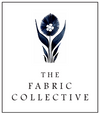DESIGNER DIARIES | 10 Questions with Brook Perdigon
What is your earliest memory of design? When did you first know that you wanted to become a fabric/wallpaper designer?
Growing up, we spent the summers at my grandparents beach house in Florida. The house was decorated in the 70s and was covered in wild patterns in shades of yellow, bright green, brown, and orange. The roman shade in my bedroom had this mesmerizing floral ogee on it and I remember lying on my bed staring at it. This is my earliest memory of design.
Can you tell us about your journey to becoming a fabric designer? Did this start from prior experience as an Interior Designer?
My background / education is in fine art and art history. After college, I realized that being a painter (as I had planned) was not an actual reality that I enjoyed. In search of something more, I began taking textile classes in weaving, dyeing, knitting, and screen printing at the College of Arts & Crafts in San Francisco while working as an elementary school art educator. I loved these courses so much that they led me to pursue a degree in surface design. My first job in the industry was for a local design studio. It was through this work that I met my current screen printer and learned the tricks of the trade.
Where do you find the inspiration for your designs? What would you say are the main influences on your work?
Antique woven textiles and art history are the main influences of my work. I love research and discovery. A huge part of my process is finding something that intrigues me and then looking at all facets of it. For instance, for my next collection I hope to create a floral/fauna design so I am currently pouring over the work of Gauguin, contemporary artist Jonas Wood, Tapa island art from the south Pacific – while also reading Joesph Conrad’s Heart of Darkness.

Fabric Designs in Seto Island and Seto Jungle
Where is the most surprising place that you’ve found inspiration for your designs?
The illustrations in my daughter’s children's books. Children’s book illustrators include a lot of whimsy in their work. They play with pattern, texture, and scale in a way that is often surprising and new.
What’s your creative process? Take us through the development of a design from idea conception to the final product.

What types of materials and production processes do you prefer to use and why?
All of our fabrics are hand screened locally in Los Angeles. Silk screen printing to this scale is an art form and I love being able to keep it alive through my work. With so much of our lives being digital, it is amazing to walk into our mill and see some of the most stunning fabrics and wallpapers on the market being created without a computer in sight.
Keeping production local is also very important to me. It keeps the environmental impact low and helps to boost our economy. Having the ability to go check in on a design or pick up our production in person also gives me the ability to be very connected to my product and the artisans who are creating it.
What is something that most people don’t understand or appreciate about textile design that you wish they did?
What advice would you give to someone who wants to experiment with adding more colour and pattern to their interiors with fabric/wallpaper but is scared of making the wrong choice?
Before I incorporate a new fabric or wallpaper pattern into my home, I live with the sample for quite some time. I tape it up, lay it over the piece, move it around the room to see how it looks with the other furnishings in the space. I find that if I am hesitant to move forward with the design then it isn’t something I am going to want to live with.
Is there a particular design in your collection that’s your favourite and if so, why?
Right now my favorite is Framework from my latest collection, Adaptation. I love the organic geometry of this design and the earthy tones we chose for the palette. It is a small scale print but it is also quite dynamic.

Sofa in Framework Terracotta and bolster in Staccato Stripe Brick. Designs on right, top to bottom: Framework Rose | Framework Ochre | Framework Cerulean | Framework Graphite
How has the fabric and textile industry evolved since you became a part of it and what do you see and hope for the future of it?
The textile industry has changed quite drastically in the past 10 years. Boutique textile lines such as mine are much more the norm than the exception. I really see designers preferring to source unique and independent resources.
COVID has only strengthened that relationship. Both interior designers and home owners want to feel connected to the products they are placing in their projects / homes. With artisan lines, that connection comes easily as there is always a unique story behind each brand and print.
Click to see Brook Perdigon's Designer Profile and explore her fabric and wallpaper collections.

